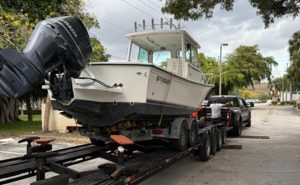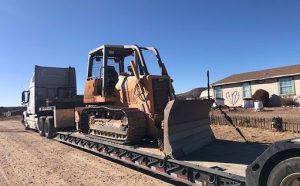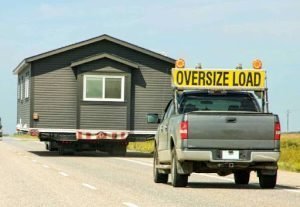Why Double Wide Mobile Home Moves Require Specialized Expertise
Finding reliable double wide mobile home movers near me can feel overwhelming when you’re facing the reality of relocating your manufactured home. Unlike standard moving jobs, double wide homes require specialized equipment, permits, and expertise that not every hauler possesses.
Quick Answer for Double Wide Mobile Home Movers:
- Cost Range: $8,500-$14,500 locally (within 1 hour), $10,000-$13,000 for 50-mile moves
- Timeline: 30-45 days advance booking, 24-48 hours for actual transport
- Requirements: Oversize permits, escort vehicles, home splitting, utility disconnection
- Key Services: Teardown, transport, blocking/leveling, skirting, utility reconnection
Double wide mobile homes present unique challenges that set them apart from single wide moves. At 24-32 feet wide and 56-76 feet long, these homes must be split into sections for transport, require specialized trailers, and need escort vehicles due to their oversized load status. The process involves removing skirting, disconnecting utilities, and coordinating multiple permits – often across state lines.
As one industry veteran noted: “Moving a mobile home isn’t as simple as it appears. There are many different points and angles of force to consider.” This complexity means scheduling moves typically 30-45 days in advance, with the actual transport taking 24-48 hours depending on road access and equipment availability.
I’m William Meyer, and over the past decade coordinating 15,000+ vehicle and equipment transports, I’ve seen how double wide mobile home movers near me searches often lead to frustration when homeowners don’t understand the specialized requirements. My experience with oversized loads has taught me that success depends on choosing movers with the right equipment, permits, and expertise for these complex relocations.

Why Moving a Double Wide Is Different
Here’s the truth: moving a double wide mobile home is like comparing a chess match to checkers. Both involve moving pieces, but one requires significantly more strategy, specialized equipment, and expertise.
The biggest game-changer is the chassis-split process. Your double wide home literally needs to be separated into two or more sections before it can hit the road. This requires understanding exactly where the home’s structural connection points are and how to safely split them without compromising integrity.
Each section must be properly supported on its own axles and wheels, which may need to be installed if the original transport equipment was removed. The load distribution has to be perfect, or you’ll have serious problems during transport.
Escort vehicles aren’t optional – they’re legally required. Any load over 8.5 feet wide needs special permits and escorts, and your double wide at 24-32 feet wide definitely qualifies as an oversized load.
HUD code compliance adds another layer of complexity. If your manufactured home was built after 1976, it must meet specific federal standards that affect transport methods and placement requirements. Your data plate becomes crucial documentation.
Skirting removal is where reality often hits hard. As one experienced mover put it: “Underpinning becomes brittle over a period of time and usually doesn’t stay together during the removal process.” Budget for new skirting at your destination.
Tie-down systems present their own challenge. Standard tie-downs are typically destroyed during removal, though PAN systems (hurricane tie-downs) can sometimes be reused.
Single-Wide vs. Double-Wide at a Glance
| Feature | Single Wide | Double Wide |
|---|---|---|
| Dimensions | Up to 18′ wide × 80′ long | 24-32′ wide × 56-76′ long |
| Transport Method | Single unit on axles | Split into 2-3 sections |
| Teardown Time | 3 hours | 6.5 hours |
| Setup Time | 4 hours | 8.5 hours |
| Cost (local) | $4,500-$7,500 | $8,500-$14,500 |
| Permits Required | Standard oversize | Multiple oversize permits |
| Escort Vehicles | Sometimes | Always required |
| Scheduling | 24 hours possible | 24-48 hours minimum |
The width difference drives most of the complexity. While single wides might squeeze through tight spots, double wides require careful route planning and may be completely restricted from certain roads.
Services You’ll Need Beyond Hauling
Moving a double wide is like conducting an orchestra – transportation is just one instrument in a much larger symphony.
Utility disconnection requires professional handling of electrical, plumbing, and gas lines. Reconnection typically requires licensed electricians and plumbers due to state regulations.
Blocking and leveling involves precise foundation work that’s crucial for your home’s structural integrity. Get this wrong, and you’ll have doors that won’t close and windows that stick.
Site grading means your destination needs proper preparation with adequate drainage and a level foundation. This might require excavation work and installing proper footings or piers.
Skirting installation becomes necessary because original skirting rarely survives removal intact. New skirting provides both curb appeal and protection for your home’s undercarriage.
Re-assembly and sealing is where the magic happens for double wides. Those two halves must be carefully rejoined and sealed, with both sections perfectly level and properly aligned.
Professional movers handle these services because they understand the technical requirements and have the proper equipment. When you’re searching for double wide mobile home movers near me, you’re really looking for a complete relocation team, not just a hauling service.
More info about mobile home moving services
Best “Double Wide Mobile Home Movers Near Me” Roundup
Finding the right double wide mobile home movers near me feels like searching for a needle in a haystack – especially when you realize that not every company advertising mobile home moves can actually handle the complexity of a double wide relocation.
The mobile home moving industry is dominated by regional networks that have built partnerships across multiple states. These companies typically have the resources and equipment inventory needed for double wide moves, unlike smaller local operators who might only handle single wides.
What sets professional double wide movers apart is their licensed and insured status combined with proper equipment. Every legitimate mover should carry DOT licensing, liability insurance, and bonding – but more importantly, they need specialized trailers and translifts that can handle the weight and dimensions of split home sections.
Pilot car availability becomes crucial since double wide moves always require escort vehicles. The best movers either maintain their own pilot car fleet or have solid partnerships with escort services.
Scheduling 30-45 days in advance is standard, not excessive. Companies promising immediate availability for double wide moves either don’t understand the complexity involved or don’t have proper equipment. The permitting process alone takes weeks in most states.
How to Vet Double Wide Mobile Home Movers Near Me
Smart vetting starts with verifying the company’s DOT number through the Federal Motor Carrier Safety Administration database. This confirms they’re legally authorized to transport oversized loads across state lines.
Insurance proof goes beyond just asking if they’re covered. Request current certificates showing both liability and cargo protection adequate for your home’s value. Written documentation beats verbal assurances every time.
Customer reviews require careful reading, particularly looking for feedback specifically about double wide moves. Check Better Business Bureau ratings and ask for recent references you can contact directly.
The written contract separates professionals from amateurs. Legitimate movers provide detailed contracts specifying all services, costs, timelines, and responsibilities. If a company only offers verbal quotes or handshake agreements, keep looking.
Red flags include companies demanding full payment upfront, lacking proper business addresses, or being unable to provide proof of specialized equipment.
Top Factors When Comparing Double Wide Mobile Home Movers Near Me
Equipment size and capability should be your primary concern. Double wide moves require specialized trailers, translifts, and heavy-duty trucks that cost hundreds of thousands of dollars. Many companies simply don’t have this equipment and will subcontract your move.
Translift availability becomes critical if your move involves challenging terrain or tight access. These hydraulic lifting systems allow homes to be moved in situations where traditional methods won’t work.
Permit handling expertise saves you significant headaches. Experienced movers should handle all permit applications, route surveys, and regulatory compliance as part of their service.
Payment terms vary widely across the industry. While cash payments are common, legitimate companies should offer multiple payment options and reasonable payment schedules. Be cautious of companies demanding full payment before any work begins.
Timeline guarantees provide peace of mind but should be realistic given the complexity involved. Companies promising unrealistic timelines often cut corners or lack proper planning.
The best double wide mobile home movers near me combine technical expertise with transparent business practices. They understand that moving your home is about more than just transportation – it’s about safely relocating your most valuable asset with minimal stress and maximum professionalism.
Cost, Permits & Paperwork Demystified

Let’s be honest – the cost of moving a double wide can feel overwhelming when you first see the numbers. But understanding what you’re actually paying for makes the investment much clearer. This isn’t just about hiring a truck driver; you’re coordinating a complex operation that involves specialized equipment, multiple permits, and skilled technicians.
The mileage rates typically run between $2.95 and $3.10 per mile for the actual transport, but here’s the thing – that’s just one piece of a much larger puzzle. Think of it like buying a car where the sticker price doesn’t include taxes, registration, or insurance. The transport fee covers getting your home from point A to point B, but not all the preparation and setup work that makes it possible.
Teardown fees cover the intricate process of preparing your home for the road. This 6.5-hour process involves carefully removing skirting (which rarely survives intact), disconnecting utilities without damaging anything, and splitting your home into transportable sections. It’s precision work that requires experience and the right tools.
Re-setup costs handle the equally complex job of putting everything back together at your new location. The 8.5-hour setup process for double wides isn’t just about parking the sections – it’s about ensuring they’re perfectly level, properly sealed, and structurally sound. You’ll be living in this home for years to come.
Pilot car fees are mandatory for double wide moves and typically cost $300-$800 depending on your route and local requirements. Some areas require multiple escort vehicles, which increases these costs. Think of pilot cars as your safety net – they’re not optional extras but legal requirements that protect you and other drivers.
Local taxes and fees can add several hundred dollars to your total, covering everything from inspection fees to hookup charges. These vary dramatically by location, so your double wide mobile home movers near me should provide a detailed breakdown of what applies in your area.
Title status becomes crucial before any move can happen. Most counties require a clear title before authorizing transport, and any liens or title issues must be resolved first. It’s like trying to sell a car with a cloudy title – the paperwork has to be clean before you can proceed.
Scientific research on manufactured housing requirements
Typical Price Ranges You Can Expect
For local moves within 50 miles, budget $10,000-$13,000 for a complete double wide relocation including all services. This covers everything from teardown through setup and represents the most common type of mobile home move. While it might seem steep, remember you’re essentially having a house disassembled, transported, and reassembled.
Long-haul moves covering 200+ miles can range from $14,000-$20,000 or more, depending on your specific route and requirements. Interstate moves add layers of complexity with multiple permit requirements and potentially different regulations at your destination. It’s like the difference between moving across town versus across the country – everything becomes more complicated.
Add-on services can significantly impact your total costs, but they’re often necessary for a complete move. Porch removal and transport typically runs $500-$1,500, while AC unit disconnection and reconnection costs $300-$800. New skirting installation ranges from $1,000-$3,000 since your original skirting likely won’t survive the move intact. Site preparation and grading can add $1,500-$5,000 if your new location isn’t ready.
Here’s some friendly advice from years of coordinating complex moves: set aside a contingency fund of 10-15% of your total estimated cost. Unexpected challenges like difficult access, weather delays, or additional permits can increase costs. Having this buffer prevents financial stress during an already complex process. Think of it as insurance for your peace of mind.
Permits, Escorts & Legal Must-Haves
Oversize load regulations vary by state, but here’s the universal truth – any load exceeding 8.5 feet in width requires special permits and escort vehicles. Double wides at 24-32 feet wide definitely fall into this category in every single jurisdiction. There’s no getting around this requirement, so factor it into your planning from day one.
Routing surveys are mandatory for most double wide moves, and they’re more involved than you might think. This involves physically driving your planned route to identify potential obstacles like low bridges, narrow roads, or sharp turns that could prevent safe passage. It’s detective work that prevents costly surprises on moving day.
State line crossings add complexity because each state has different requirements. Some states require additional permits, inspections, or escort requirements that don’t apply to moves within a single state. It’s like international travel – crossing borders means more paperwork and regulations.
The data plate from IBTS (Institute for Building Technology and Safety) provides crucial documentation about your home’s specifications and compliance with federal standards. This document is often required for permits and may be needed at your destination for local approvals. Think of it as your home’s birth certificate – you’ll need it to prove legitimacy.
Manufactured Home Information in Colorado
Preparation & Timeline Checklist

Getting your double wide ready for the big move isn’t something you can tackle the night before. The preparation process starts weeks in advance and requires careful coordination.
Decluttering your home is the first step that many people underestimate. Every extra pound adds to transport costs, and loose items become dangerous projectiles during the splitting process.
Securing your interior means thinking like everything inside will be on a carnival ride. Cabinet doors need latching, loose fixtures should be removed, and anything breakable needs serious protection.
Skirting removal often reveals surprises that nobody wants to find on moving day. That’s why experienced double wide mobile home movers near me handle this step early in the process.
Photographing everything protects you legally and helps with insurance claims if something goes wrong. Take detailed shots of your home’s condition inside and out, paying special attention to any existing damage.
Clearing trees along your route isn’t optional – it’s a safety requirement. Double wides need significant clearance, and route surveys identify these issues.
Your foundation preparation at the destination site should be completed before your home arrives. This includes proper grading, pier installation, and utility hookup preparation.
30-Day Countdown Plan
The magic number for double wide moves is 30 days – that’s when you need to start the permit process. Day 30 is when all your oversize load permits get filed, along with any special route approvals.
Day 15 brings utility disconnection notices. Electric, gas, and water companies need advance warning, and you’ll want licensed professionals lined up for reconnection at your destination.
Day 5 starts the physical preparation with skirting removal and interior securing. This is also your last chance to make any repairs needed to get your home “road worthy.”
Day 1 is final inspection time. All permits should be approved, escort vehicles scheduled, and the transport route cleared of obstacles.
Day-Of-Move Playbook
Moving day arrives with carefully orchestrated chaos. The process starts with splitting the halves using specialized hydraulic equipment. This isn’t just about disconnecting utilities – it’s about safely separating a structure that was designed to be permanent.
Loading with cranes requires precision. Each section must be positioned perfectly on transport trailers with proper weight distribution.
The escort briefing brings together your pilot car operators and transport team to review the route, communication procedures, and safety protocols.
Road clearance is where all that advance planning pays off. The convoy moves along the predetermined route with escorts managing traffic and ensuring safe passage through tight spots.
Arrival setup reverses the entire process at your destination. The sections are carefully positioned, rejoined, and initial setup begins.
Frequently Asked Questions About Double Wide Moves
When homeowners start researching double wide mobile home movers near me, they often have similar concerns about the process. Let me address the most common questions I hear from people planning these complex moves.
What size or age limits apply?
The good news is that most double wide homes can be moved regardless of when they were built. However, homes manufactured before 1976 present some unique challenges since they don’t meet current HUD standards. This doesn’t automatically disqualify them from moving, but it may limit where they can be relocated or require additional inspections.
Structural integrity matters more than age alone. I’ve seen 40-year-old homes move successfully because they were well-maintained, while newer homes with foundation issues required extensive repairs before transport. Your mover should conduct a thorough inspection to assess whether your home is “road worthy.”
Size restrictions typically come from local road conditions rather than the home itself. Homes exceeding 17 feet in height may need roof modifications like removing AC units or vents to clear bridges and power lines. Extremely long homes over 90 feet might require special routing or additional permits, but this is manageable with proper planning.
The width is rarely an issue since double wides are designed to split for transport. However, some older homes may have structural modifications that complicate the splitting process, which is why experienced movers always inspect the home before providing final quotes.
How long does a full move take?
This is probably the most important question for planning purposes. The complete process from your first call to being settled in your relocated home typically takes 4-6 weeks. Here’s how that breaks down:
Permit processing eats up 2-3 weeks of your timeline. Oversize load permits, route surveys, and local approvals can’t be rushed. States have specific processing times, and trying to expedite usually backfires.
Scheduling and preparation require another 1-2 weeks. This includes coordinating utility disconnections, arranging escort vehicles, and completing any necessary repairs. Good movers book out 30-45 days in advance, so factor this into your planning.
The actual transport takes just 24-48 hours in most cases. Local moves within 50 miles can sometimes be completed in a single day, while longer distances or challenging routes may require overnight stops.
Setup and finishing work spans 2-3 days after arrival. This includes rejoining the home sections, blocking and leveling, utility reconnections, and skirting installation. Weather delays, permit hiccups, or unexpected complications can extend this timeline, so build in some buffer time.
Can attached decks or porches travel too?
Yes, attached structures can usually make the journey with your home, but they require separate handling and add complexity to the move. Porches and decks are typically disconnected from the main home, transported on separate trailers, then reconnected at your new location.
This separate transport adds both cost and time to your move. Expect to pay an additional $500-$1,500 for porch removal and transport, depending on the size and complexity of the structure. The good news is that most experienced movers handle this routinely and can reassemble everything properly at the destination.
Built-in features like attached carports or storage sheds may also be moveable depending on their construction and local regulations. Some structures are easier to rebuild than transport, especially if they’re showing their age or weren’t built to travel.
Your mover should evaluate each attached structure individually. Sometimes it makes more financial sense to rebuild at the destination rather than transport, especially for older or deteriorating additions. A honest assessment during the initial inspection helps you make the best decision for your situation and budget.
Conclusion
Moving a double wide mobile home isn’t something you want to tackle with just any hauler. The specialized nature of these relocations – from splitting your home into sections to coordinating escort vehicles and permits – requires double wide mobile home movers near me who truly understand what they’re doing.

The $10,000-$20,000 investment for a complete double wide move might seem steep at first glance, but it reflects the reality of what’s involved. You’re not just paying for transport – you’re investing in expertise that ensures your home arrives safely and gets properly reassembled at its new location.
Think about it: your mobile home represents stability, memories, and likely your largest asset. Cutting corners on the move to save a few thousand dollars could end up costing you everything if something goes wrong. Professional movers bring the right equipment, proper insurance, and years of experience handling these complex relocations.
At We Will Transport It, we’ve seen how overwhelming the search for reliable movers can be. Our experience with oversized loads and complex logistics means we understand the unique challenges double wide moves present. We provide the transparent pricing and real-time updates that help remove the stress from an already complicated process.
The 30-45 day scheduling window might test your patience, but it’s actually working in your favor. This time allows for proper permit processing, route planning, and coordination of all the moving parts – literally and figuratively. Rushed moves are where problems happen.
Your double wide move doesn’t have to be a nightmare scenario. With proper planning, professional execution, and realistic expectations about timeline and costs, you can successfully relocate your home to its new foundation.
Ready to get started? We’ll walk you through every step of the process, from initial assessment through final utility reconnection. Our team understands that this isn’t just about moving a structure – it’s about moving your home.




